Publié le 5 septembre 2020
On the 3rd of September, two Belgian CubeSats, PICASSO (from the Royal Belgian Institute for Space Aeronomy) and SIMBA (from the Royal Meteorological Institute) were launched simultaneously with about 50 tiny satellites, on board Europe’s inaugural Vega SSMS flight.
CubeSats are very small satellites orbiting the Earth. They are made of cubes ('units') of 10cm x 10cm x 10cm and are very light. PICASSO, just like SIMBA, consists of 3 of these cubes and weighs only 3.5 kg.
Simba for solar irradiance measurements
 SIMBA, short for ‘Sun-Earth Imbalance’ is a CubeSat developed with ESA by a consortium led by Belgium’s Royal Meteorological Institute (RMI) with the University of Leuven and ISIS-Innovative Solutions in Space in the Netherlands.
SIMBA, short for ‘Sun-Earth Imbalance’ is a CubeSat developed with ESA by a consortium led by Belgium’s Royal Meteorological Institute (RMI) with the University of Leuven and ISIS-Innovative Solutions in Space in the Netherlands.
The main origin of climate change is that an increasing amount of heat from the Sun is being retained within the atmospheric system. To quantify that directly we need to measure how much solar energy Earth is receiving – we call this the total solar irradiance – then how much of this is being reflected by the Earth’s surface and atmosphere, or being radiated out as longer-wavelength heat energy.
Subtracting the second from the first, we end up with a figure for Earth’s radiation budget – the amount of energy our planet holds onto rather than reflects or radiates away.
The idea with Simba is to achieve higher absolute accuracy by employing the same instrument for the very first time to measure irradiance from both the Sun and Earth.
Didier Fussen, heading the Solar Radiation Department at BISA
PICASSO CubeSat to sift secrets from sunrise
PICASSO (for PICo-Satellite for Atmospheric and Space Science Observations) will use the filtering of sunlight by the Earth’s atmosphere during sunrise and sunset to monitor the vertical distribution of ozone in the stratosphere, using the VISION (Visible Spectral Imager for Occultation and Nightglow) instrument.
By tracking the deformation of the solar disk image by atmospheric refraction, VISION will also be able to determine the temperature profile throughout the terrestrial stratosphere and mesosphere.
In addition, the Sweeping Langmuir Probes (SLP), mounted on the end of four solar panels, will help to determine the electron density and temperature in the local space environment, together with the ion density and the electrical potential of the satellite, from the small electrical currents they measure in PICASSO’s orbit. These will then give better insight into the magnetosphere-ionosphere coupling and aurora.
Simba and PICASSO have been supported by the Belgian Science Policy Office through the ‘Fly’ element of ESA’s General Support Technology Programme, readying promising technologies for space.
More information
Two Belgian CubeSats launched successfully - Royal Belgian Institute for Space Aeronomy
Lancement de deux satellites belges (IRM et IASB) - Institut royal Météorologique
Lancering van twee Belgische satellieten (KMI en BIRA) - Koninklijk Meteorologisch Instituut